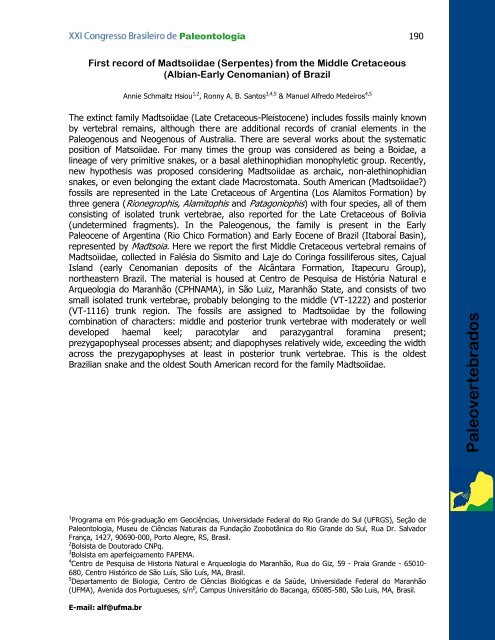Livro de Resumos - Dinossauros do Maranhão
Livro de Resumos - Dinossauros do Maranhão
Livro de Resumos - Dinossauros do Maranhão
You also want an ePaper? Increase the reach of your titles
YUMPU automatically turns print PDFs into web optimized ePapers that Google loves.
Paleontologia 190<br />
First record of Madtsoiidae (Serpentes) from the Middle Cretaceous<br />
(Albian-Early Cenomanian) of Brazil<br />
1<br />
Programa em Pós-graduação em Geociências, Universida<strong>de</strong> Fe<strong>de</strong>ral <strong>do</strong> Rio Gran<strong>de</strong> <strong>do</strong> Sul (UFRGS), Seção <strong>de</strong><br />
Paleontologia, Museu <strong>de</strong> Ciências Naturais da Fundação Zoobotânica <strong>do</strong> Rio Gran<strong>de</strong> <strong>do</strong> Sul, Rua Dr. Salva<strong>do</strong>r<br />
França, 1427, 90690-000, Porto Alegre, RS, Brasil.<br />
2<br />
Bolsista <strong>de</strong> Doutora<strong>do</strong> CNPq.<br />
3<br />
Bolsista em aperfeiçoamento FAPEMA.<br />
4<br />
Centro <strong>de</strong> Pesquisa <strong>de</strong> Historia Natural e Arqueologia <strong>do</strong> <strong>Maranhão</strong>, Rua <strong>do</strong> Giz, 59 - Praia Gran<strong>de</strong> - 65010-<br />
680, Centro Histórico <strong>de</strong> São Luís, São Luís, MA, Brasil.<br />
5<br />
Departamento <strong>de</strong> Biologia, Centro <strong>de</strong> Ciências Biológicas e da Saú<strong>de</strong>, Universida<strong>de</strong> Fe<strong>de</strong>ral <strong>do</strong> <strong>Maranhão</strong><br />
(UFMA), Avenida <strong>do</strong>s Portugueses, s/n 0 , Campus Universitário <strong>do</strong> Bacanga, 65085-580, São Luis, MA, Brasil.<br />
E-mail: alf@ufma.br<br />
Annie Schmaltz Hsiou 1,2 , Ronny A. B. Santos 3,4,5 & Manuel Alfre<strong>do</strong> Me<strong>de</strong>iros 4,5<br />
The extinct family Madtsoiidae (Late Cretaceous-Pleistocene) inclu<strong>de</strong>s fossils mainly known<br />
by vertebral remains, although there are additional records of cranial elements in the<br />
Paleogenous and Neogenous of Australia. There are several works about the systematic<br />
position of Matsoiidae. For many times the group was consi<strong>de</strong>red as being a Boidae, a<br />
lineage of very primitive snakes, or a basal alethinophidian monophyletic group. Recently,<br />
new hypothesis was proposed consi<strong>de</strong>ring Madtsoiidae as archaic, non-alethinophidian<br />
snakes, or even belonging the extant cla<strong>de</strong> Macrostomata. South American (Madtsoiidae?)<br />
fossils are represented in the Late Cretaceous of Argentina (Los Alamitos Formation) by<br />
three genera (Rionegrophis, Alamitophis and Patagoniophis) with four species, all of them<br />
consisting of isolated trunk vertebrae, also reported for the Late Cretaceous of Bolivia<br />
(un<strong>de</strong>termined fragments). In the Paleogenous, the family is present in the Early<br />
Paleocene of Argentina (Rio Chico Formation) and Early Eocene of Brazil (Itaboraí Basin),<br />
represented by Madtsoia. Here we report the first Middle Cretaceous vertebral remains of<br />
Madtsoiidae, collected in Falésia <strong>do</strong> Sismito and Laje <strong>do</strong> Coringa fossiliferous sites, Cajual<br />
Island (early Cenomanian <strong>de</strong>posits of the Alcântara Formation, Itapecuru Group),<br />
northeastern Brazil. The material is housed at Centro <strong>de</strong> Pesquisa <strong>de</strong> História Natural e<br />
Arqueologia <strong>do</strong> <strong>Maranhão</strong> (CPHNAMA), in São Luiz, <strong>Maranhão</strong> State, and consists of two<br />
small isolated trunk vertebrae, probably belonging to the middle (VT-1222) and posterior<br />
(VT-1116) trunk region. The fossils are assigned to Madtsoiidae by the following<br />
combination of characters: middle and posterior trunk vertebrae with mo<strong>de</strong>rately or well<br />
<strong>de</strong>veloped haemal keel; paracotylar and parazygantral foramina present;<br />
prezygapophyseal processes absent; and diapophyses relatively wi<strong>de</strong>, exceeding the width<br />
across the prezygapophyses at least in posterior trunk vertebrae. This is the ol<strong>de</strong>st<br />
Brazilian snake and the ol<strong>de</strong>st South American record for the family Madtsoiidae.<br />
Paleovertebra<strong>do</strong>s


